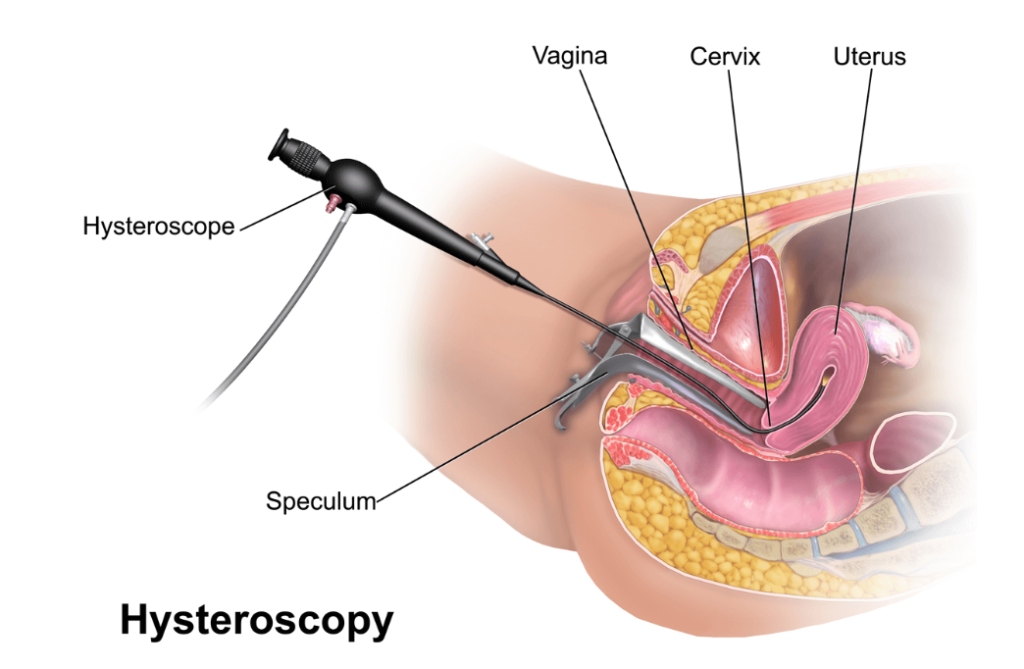What is a Hysteroscopy?
A hysteroscopy is a procedure that allows your practitioner to look inside your uterus by passing a very small telescope through the cervical canal. A hysteroscopy allows the practitioner to evaluate the inside of the uterus. The procedure involves passing an ultra-thin camera in to the uterus through the vagina. Scar tissue inside the uterine cavity can be cut, and polyps and fibroids can be removed. If there is a wall (septum) dividing the uterine cavity in two, it can be removed.
Why is hysteroscopy done?
One of the most common uses for hysteroscopy is to find the cause of abnormal uterine bleeding. Abnormal bleeding can mean that a woman’s menstrual periods are heavier or longer than usual or occur less often or more often than normal. Bleeding between menstrual periods also is abnormal but I common in menopausal women and those on hormone replacement. This bleeding can be treated and eliminated.

Hysteroscopy also is used in the following situations:
Remove adhesions that may occur because of infection or from past surgery
Diagnose the cause of repeated miscarriage when a woman has more than two miscarriages in a row
Locate an intrauterine device
See if polyps or fibroids are present
Where is my hysteroscopy performed?
We perform hysteroscopy in our office’s surgical room. This allows you to avoid the high costs and infection risks associated with hospitals.
About my procedure appointment
You will be given an motrin to take 1 hour before your appointment. When you arrive, you will be given a shot of atropine and toradol prior to the procedure to relax you. These medications do not cause drowsiness, so you may drive yourself to and from the appointment.
What to expect during the procedure?
The procedure is completely painless. Local anesthesia is used to block any pain. To make the procedure easier, your practitioner may dilate (open) your cervix before your hysteroscopy. You may be given medication that is inserted into the cervix, or special dilators may be used.
A speculum is first inserted into the vagina. The hysteroscope is then inserted and gently moved through the cervix into your uterus. Saline (salt water), will be put through the hysteroscope into your uterus to expand it. The fluid helps your practitioner see the lining more clearly. Your practitioner can view the lining of your uterus and the openings of the fallopian tubes by looking through the hysteroscope. Small instruments will be passed through the hysteroscope if a biopsy or other procedure is done.
What should I expect after the procedure?
After your hysteroscopy, you may expect some menstrual type cramping or spotting for a few days. You will be discharged with another motrin to take later. If you have any further questions or concerns after your procedure, please contact our office.
When will we discuss the findings and treatment options?
You will schedule a follow up appointment for 4-7 days after your procedure at which time the findings will be discussed, and a plan made for any future therapy.
Are there any potential complications?
Fortunately, any complications from hysteroscopy are very rare. You should call the office if you are concerned about any problems especially severe cramping, nausea or vomiting, heavy vaginal bleeding (more than a period), or a temperature greater than 101 F.
Is Hysteroscopy covered by insurance?
Most often, insurance providers do cover hysteroscopy cost. This varies based on insurance company and plan. We will verify coverage and discuss this with you.
How to begin
The practitioner will determine if a hysteroscopy is necessary after conducting a full exam, obtaining medical history, and, in many cases, performing an ultrasound. If a hysteroscopy is necessary, we will discuss the need with you, discover insurance coverage, and help you choose a treatment date. A deposit may be required to book and secure your appointment.

